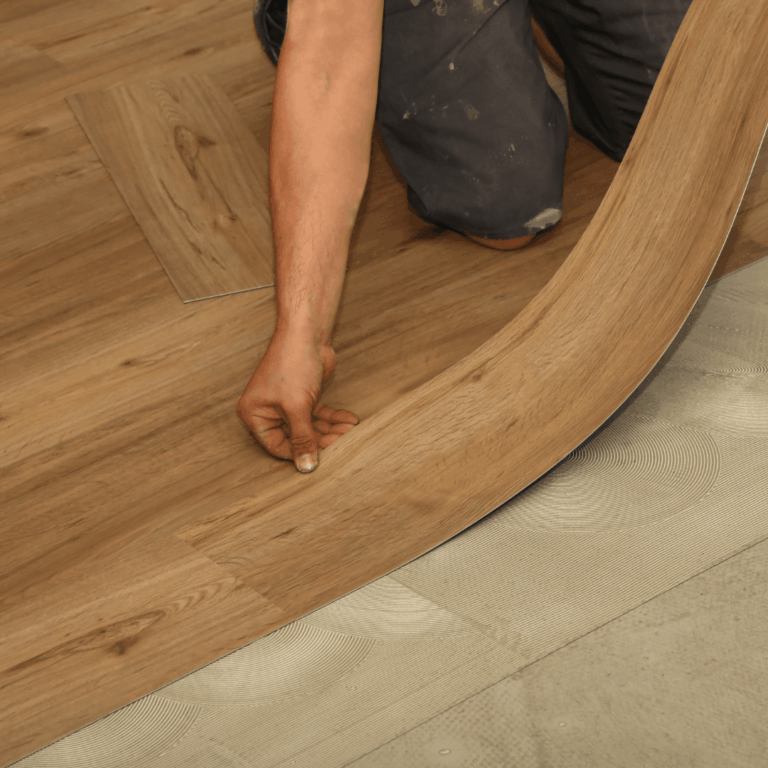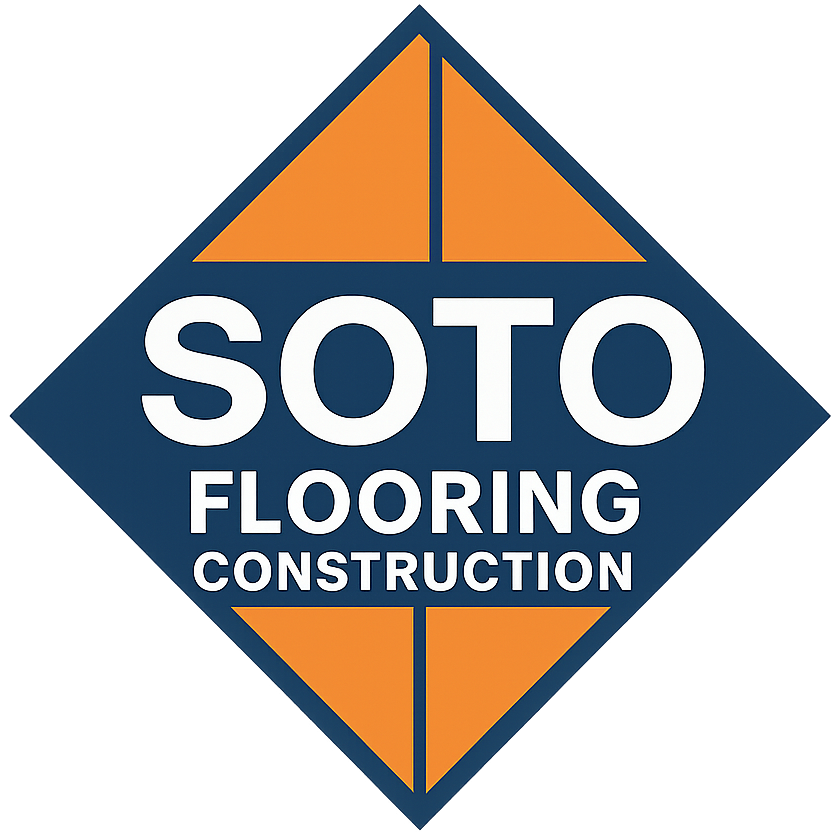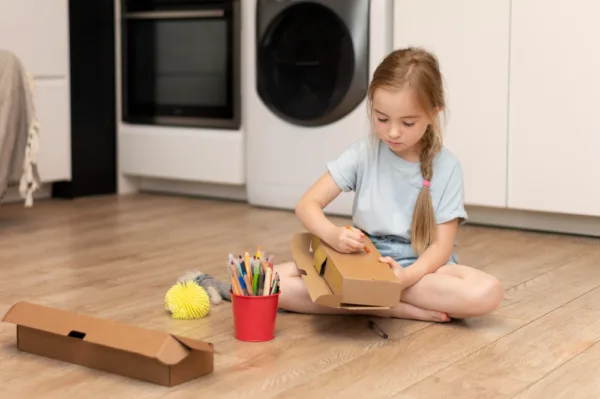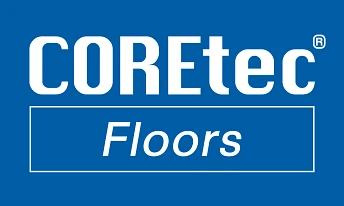
Everything You’ll Need
| Tool | Luxury Vinyl Plank (LVP) | Luxury Vinyl Tile (LVT) | Sheet Vinyl |
|---|---|---|---|
| Utility Knife | ✔ | ✔ | ✔ |
| Tape Measure | ✔ | ✔ | ✔ |
| Straight Edge | ✔ | ✔ | ✔ |
| Pry Bar | ✔ | ✔ | ✔ |
| Spacers | ✔ | ✔ | ❌ |
| Tapping Block | ✔ | ❌ | ❌ |
| Non-Marring Hammer | ✔ | ❌ | ❌ |
| Squeegee | ❌ | ✔ | ❌ |
| Grout Float | ❌ | ✔ | ❌ |
| Notched Trowel | ❌ | ✔ | ✔ |
| Floor Roller | ❌ | ❌ | ✔ |
| Heat Gun | ❌ | ❌ | ✔ |
| Seam Roller | ❌ | ❌ | ✔ |
Step 1: Prepare the Space
Take Off Baseboards and Old Flooring
Start by taking out any baseboards and old flooring from your room to prepare for vinyl plank flooring. This will leave you with a clear floor to start with.
Carefully use a pry bar to remove the baseboards without damaging the walls.
For carpet, cut it into smaller pieces with a utility knife and pull it up. Follow the right steps for removing other floor types.
Clean the Subfloor and Fix Cracks or Uneven Spots
Thoroughly sweep and vacuum the subfloor to get rid of all dirt and debris. Check for any cracks or uneven areas.
Fill any gaps or low areas with a leveling compound, and sand down high areas to make the surface even.
Add Underlayment for Extra Comfort and Quietness
Adding underlayment isn’t always needed, but it can make the floor softer and quieter.
If you decide to use underlayment, roll it over the subfloor and use adhesive tape to secure it, making sure there are no gaps or overlaps.
Step 2: Pick a Pattern or Design
Vinyl floor patterns give you many design choices to make your space look great.
From old-fashioned to modern, these patterns help create unique floors that match your style.
Check out some popular vinyl flooring patterns that can improve your home.
Straight Lay Pattern

The straight lay pattern is simple for vinyl floors. The planks are laid parallel, going the same way as the walls. This makes a neat look that suits any room, like bedrooms or living areas.
Diagonal Pattern

Try a diagonal pattern for a lively and interesting look. The planks are at a 45-degree angle to the walls, adding movement and depth. This can make small rooms feel bigger and add drama to larger spaces.
Herringbone Pattern

The herringbone pattern is a classic choice. Planks are laid in a zigzag, making a V-shaped pattern. This adds texture and style, perfect for entryways, kitchens, and dining rooms.
Chevron Pattern

The chevron pattern is another trendy option. Planks are laid in a continuous zigzag. This gives a modern touch, great for contemporary spaces.
Parquet Pattern

Parquet patterns use vinyl planks in shapes like squares or diamonds. These designs can be simple or complex.
Parquet patterns add interest and elegance, popular for formal living rooms, offices, and commercial areas.
Mixed Patterns

Mixing different vinyl floor patterns can create a unique look. This lets you design floors that show your style.
For example, a straight lay pattern with a herringbone border or a checkerboard pattern with contrasting colors.
Step 3: Choose an Installation Method
There are different ways to install vinyl plank flooring. Each way has its own pros and cons, depending on the type of vinyl and your needs.
GripStrip Method

GripStrip, or peel-and-stick, is one of the easiest ways to install vinyl plank flooring.
Each plank has a sticky back. Just peel off the film and stick the planks to the floor.
GripStrip works well with Luxury Vinyl Plank (LVP) flooring, which is thick and sturdy. It may not work for thinner vinyl like Luxury Vinyl Tile (LVT) or Sheet Vinyl.
Click-Lock Method

Click-Lock, or interlocking, uses planks with edges that snap together to make a strong bond.
This method doesn’t need glue and lets the floor “float” over the base, changing with temperature and humidity.
Click-Lock works for both LVP and LVT flooring and some Sheet Vinyl.
Take Note:
- Follow the instructions to align and lock the planks properly to avoid gaps or uneven seams.
- Use spacers along the walls for expansion gaps so the floor can move without buckling.
Glue-Down Method

Glue-down uses adhesive on the floor before pressing the vinyl planks in place.
This method gives a strong, lasting bond, great for busy areas.
It provides a stable floor that handles heavy traffic and moisture.
Take Note:
- Pick a good adhesive made for vinyl flooring.
- Work in small areas so the adhesive stays sticky.
- Use a roller to press the planks and ensure they stick well.
- Let the adhesive dry before walking on the floor or adding heavy items.
Step 4: Lay the First Row
Cut the Short Edge of the First Plank
To begin the first row, cut the short edge of the first plank. This helps the plank fit well against the wall. Use a utility knife to cut cleanly along the edge.
Place the First Plank 1⁄4 Inch from the Wall
Put the first plank about 1⁄4 inch from the wall. This gap lets the floor expand with changes in temperature and humidity. Use spacers next to the wall to keep this gap.
Use Spacers for Expansion
Put spacers between the planks and walls to keep the 1/4-inch gap for expansion. These spacers help your floor…
Step 5: Cutting Planks to Fit
Use a Utility Knife to Score and Snap Planks
To cut planks for corners and edges, use a utility knife to score along the cut line. Then, snap the plank along this line for a clean break.
For Irregular Cuts
Use a jigsaw or oscillating multi-tool for irregular cuts like around door frames or pipes. These tools are great for precise and complex shapes. Learn how to use a jigsaw here.
Cutting Planks Around Pipes
Measure the pipe’s diameter and add an inch. Drill a hole in the plank matching this size. Cut the plank to fit around the pipe, leaving a half-inch expansion gap. Install the plank and use silicone caulk to secure the cut piece.
For Tight Spaces Like Under Door Jambs
Use a jamb saw for cutting planks to fit in tight spaces like under door jambs. This tool makes precise cuts close to the floor, allowing planks to fit neatly.
Step 6: Laying Subsequent Rows
Angle the Tongue of the Plank into the Groove of the Previous Row
To install subsequent rows, angle each plank’s tongue into the groove of the previous row. This will lock the planks together and create a secure, seamless connection.
Use a Tapping Block and Non-Marring Hammer
To ensure a tight fit, use a tapping block and non-marring hammer to tap the planks into place gently. Avoid using a regular hammer directly on the planks, which can cause damage.
Step 7: Finishing the Installation
Install Transition Strips
Once all the planks are laid, install transition strips at doorways and between rooms to provide a smooth transition and protect the edges of the flooring. Follow the manufacturer’s instructions for installing transition strips.
Transitioning to Other Flooring
When transitioning to a different flooring type, use a T-molding or reducer strip. Attach the transition strip to the subfloor rather than the vinyl planks to ensure a secure and professional finish.
Also, a 1/4-inch expansion gap between the vinyl planks and the transition strip should be left to accommodate any potential movement and prevent buckling.
Reinstall Baseboards
Reinstall the baseboards, ensuring they are secured to the wall and not the floor. This allows the flooring to expand and contract without obstruction.
Allow the Floor to Acclimate for 48 Hours Before Use
Allow the newly installed floor to acclimate for 48 hours before walking on it or placing furniture. This period will ensure the flooring adjusts to the room’s temperature and humidity.
Common Things to Avoid When Installing Vinyl Floors
Areas with Excessive Moisture
Vinyl plank flooring is unsuitable for areas with excessive moisture, such as bathrooms. Moisture can seep into the seams and cause the planks to warp or peel.
Using a Rubber Mallet or Hammer Directly on the Planks
Using a rubber mallet or hammer directly on the planks can cause damage. Always use a tapping block to protect the planks during installation.
Don’t Overlap the End Joints of the Planks in Adjacent Rows
Avoid overlapping the end joints of planks in adjacent rows. Overlapping joints can weaken the floor’s structure and create an uneven surface.
Walking on the Floor During the Acclimation Period
Do not walk on the floor during the 48-hour acclimation period. This time is crucial for settling the floor and ensuring a long-lasting installation.
Tips for a Successful Vinyl Flooring Installation
- Before you begin, measure the room accurately and calculate the amount of flooring needed. Add an extra 10% to account for cutting and waste.
- Inspect each plank before installation and discard any damaged pieces. This will ensure a flawless final look.
- Use a knee pad for comfort during the installation process. This will help protect your knees and make the job more comfortable.
- Take your time and work carefully to avoid mistakes. Rushing can lead to errors and a less professional finish.
Installation Costs for Vinyl Plank Flooring
Installing vinyl plank flooring involves various costs depending on the method chosen:
- Peel-and-stick: Typically ranges from $1.50 to $8 per square foot.
- Glue-down: Costs can be between $2.50 and $12.50 per square foot.
- Floating/Interlocking: Generally falls between $3 and $13 per square foot.
Labor costs vary from $1 to $3 per square foot based on the complexity of the installation.
Additional expenses might include underlayment, costing $0.50 to $1.00 per square foot, and transition strips and trim, ranging from $1 to $5 per linear foot, necessary for a polished finish.
Do You Need Professional Help With Your Vinyl Flooring Installation Project?
Now that you’ve learned how to install vinyl plank flooring, you’re well on your way to creating a beautiful, durable floor. But if you’d prefer to leave the heavy lifting to the experts, we’re here to help.
Our flooring installation team can handle everything — from proper subfloor preparation to precise plank placement — so you can relax and enjoy flawless results. We’ll also help you choose the right vinyl flooring for your space, whether it’s luxury vinyl plank, sheet vinyl, or tile.
Contact us today to schedule your free in-home consultation and see if we serve your area.





